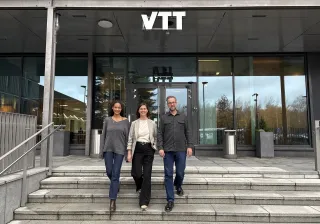Lately, we have been experiencing a global shortage of semiconductors, and everyone has felt the effects. The situation has caused interruptions in supply chains, delays in deliveries and increases in prices. Some companies have even been forced to remove features and redesign their products.
At the same time, the demand for digital products and services is at an all-time high. And the need for digitalisation is only growing.
How can Europe ensure supply in similar market situations in the future, and meet the increasing demands for digital transformation? Let’s explore.
Big business taking things into their own hands
One of the impacts of the global chip shortage is that large, globally operating companies are coming to grips with the lack of control they have over the supply chain. Tired of the continuing crisis and unreliable logistics chains, many companies have now become interested in establishing semiconductor production sovereignty and managing their own supply chains.
The automotive industry, for example, has already set up their own, large electronics design departments to gain more control over the supply chain. By designing their own integrated circuits and system-on-chips (SoC), they are also gaining control over the capabilities of their devices. Thus, the automotive industry is not only reducing the element of uncertainty, but also increasing their ability to tailor products to fit their needs.
EU Chips Act aims for chips sovereignty
The European Union has also recognised the need to respond to the chip shortage. In the future, the EU aims to increase its semiconductor manufacturing capacity and be more independent when it comes to these crucial components.
Currently, the semiconductor industry is dominated by East Asia and North America. To free itself from this dependence, EU has introduced the European Chips Act – an initiative with the aim of building a state-of the-art chip ecosystem in Europe. The EU is also planning to increase Europe’s share of semiconductor production from 10% to 20% by 2030.
To achieve its goals, the European Union needs to attract new talent, build new infrastructure, and invest in research and development.
Investments into the European semiconductor industry needed
Having the political will to boost European production is not enough on its own. What needs to follow are investments that make these visions a reality.
To reduce its current reliance on chips made in Asia, the European Union needs to increase the capacity of European factories as well as attract overseas production operations back to Europe. Doing this requires incentives. The European Commission has already committed to allocate 15 billion euros in additional public and private investment in the industry by 2030, but local funding and grants are still needed.
Global semiconductor giants such as Intel, STMicroelectronics and GlobalFoundries are already showing signs of wanting to return and grow their business in Europe: All of them have announced plans to set up new factories and invest billions of euros in Europe in the next few years.
This clearly shows that with the right investment aids, Europe is indeed able to attract global companies.
World-class expertise makes Finland an attractive destination for investments
Finland has long been renowned for its unique technology expertise and a world-class educational system in the field of deep tech. We have proven that we have what it takes to become a trailblazer in the research, development and manufacturing of high added-value technologies. This is demonstrated by success stories such as Suunto’s sport watches, Nokia’s mobile networks and Kone’s elevators.
Now, what we need to do is invest in becoming deep-tech experts. We already have word-class expertise in quantum technologies as well as in microelectronics and integrated photonics used in sensor technologies and in telecommunications. Pair that with European manufacturing capabilities that ensure better resilience against global supply chain disruptions, and you’ll have a winning, highly competitive combination.
To get us there, we need firm political will and public funding. We should be investing in building next-generation capabilities as well as the necessary infrastructure for manufacturing today. Only then can we have a leg up on the competition in the future.
We have already seen that the right infrastructure and the right expertise attract business. Thus far over 20 international companies have set up their R&D departments around Micronova, Finland's national research infrastructure for micro- and nanotechnology.
Finland’s next big investment should be a new research, development and manufacturing facility for quantum technologies, microelectronics, radio frequency technologies and photonics. It would open up a world of opportunities for businesses, Finland and Europe.
The time to act is now
The global shortage of semiconductors has shown us that Europe needs capacity to produce semiconductors. It is not only crucial to staying competitive, but also to ensuring supply chain resilience. To gain a greater foothold in the chip ecosystem means Europe needs to attract the right people, infrastructure and investments. The European Chips Act is a step in the right direction, but we also need global cooperation and local funding. By establishing more tech sovereignty, EU will ensure it is holding the keys to its own future.
Read more:
Leading international RDI hub for microelectronics and quantum technology planned for Finland








